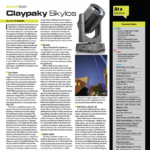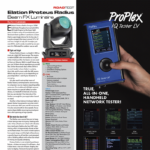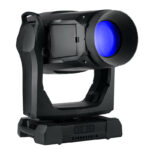A wasp, hornet, yellow jacket, or honeybee? Which of these have anything to do with a moving light? All the buzz is because Clay Paky, Italian based lighting manufacturer and maker of the popular Sharpy, has taken the beautiful naturally occurring honeycomb pattern and applied it as a front lens to its latest wash light, the A.leda B-Eye K20.
The A.leda series is Clay Paky’s LED wash light family. The number following the K classifies the size. K20 is the biggest and brightest, followed by a smaller K10 version and, finally, the baby K5. B-Eye is the newest addition to the A.leda lineup and contains the rotating honeycomb front lens for the K20 and K10 models.
Exterior
 Weighing in at just over 46 lbs., the K20 can be handled by a single worker. It hangs by two omega-style brackets that attach with two quarter-turn wing bolts, each of which have three holes to accept clamps or couplers to a spacing of your liking.
Weighing in at just over 46 lbs., the K20 can be handled by a single worker. It hangs by two omega-style brackets that attach with two quarter-turn wing bolts, each of which have three holes to accept clamps or couplers to a spacing of your liking.
On the rear of the base is the input/output panel. On the left sits a vertically mounted power rocker switch. Next is a blue Neutrik powerCON input, followed by 3- and 5-pin DMX connectors. Last is a single Ethernet port, which opens the door to networking (more on this later).
The only item on the front of the base is the display with navigation arrows. Behind the display is a battery, which allows the menu to be accessed, even when the fixture is powered off — a useful feature for rental shops when pre-addressing fixtures for shows.
The honeycomb lens is approximately 9.75 inches in diameter and moves in and out to achieve the zoom. Be sure to remember to retract the lens prior to returning the fixture to its road case. The pan can be locked for transport via a lever on the lower side of the arm.
Interior
The head contains 37 Osram RGBW chipsets rated at 15 watts each. Adding in the power supply and motors, the fixture consumes 750 VA of power with acceptable voltage range of 100-240. On the effect channel, the dimmer curves, RGBW curves and halogen lamp simulation can be changed. I view this channel as more of a control than an effect channel, but it’s great to have the option to change the settings right from the console for each show, or even from cue-to-cue.
On curve setting 1 (Linear), the intensity moved quickly on the low end, but curve setting 2 (Gamma 1.5) smoothed it out. A slight but noticeable color shift occurs when dimming all RGBW values at once. The halogen lamp simulation changes the default white. Instead of RGBW at full, it mixes the colors to achieve a halogen, 3000K white as a starting point. Furthermore, it has five settings to adjust the output brightness between 750 and 2,500 watts.
The color mixing is excellent and has 53 Lee referenced colors in the color macro channel. Even a “Black” color, with all values at 0, is included, which is useful to programmers. There is a variable color temperature channel ranging from 2500 to 8000K.
The zoom, achieved by adjusting the honeycomb lens’ distance from the LED chipsets, varies between 4° and 60°, and it can move from one extreme to the other in .67 seconds. This feature alone allows the light to serve many purposes, from a wide wash to long, narrow beam.
When the zoom lens is wide, or close to the LEDs, the square chipsets are visible and do not fill the honeycomb lens (see photo, left). When narrow and away from the LEDs, the entire front lens is filled with light (see photo, right).
Operation
There are five different modes to operate the fixture in. Standard mode is 21 channels with typical moving light controls but no shape control. Shapes mode is 35 channels and what I believe most users will select. The remaining three contain individual pixel control typically for pixel mapping and range from 132 to 169 channels.
Some users patch the fixture into two parts, K-20 B-Eye and Shapes. This allows for the console’s color picker, RGB/CMY values, and therefore same palettes, to be used on both the main color mixing as well as the color of the shapes or effects.
 As the channel counts continue to grow on new fixtures, so does the need for more universes of DMX. The only DMX-over-Ethernet protocol the B-Eye accepts is Art-Net; it operates in the 2.xxx.xxx.xxx or 10.xxx.xxx.xxx IP range. There is no Ethernet output connection to daisy chain fixtures, but the fixture can receive Ethernet in and output DMX, acting an Ethernet node.
As the channel counts continue to grow on new fixtures, so does the need for more universes of DMX. The only DMX-over-Ethernet protocol the B-Eye accepts is Art-Net; it operates in the 2.xxx.xxx.xxx or 10.xxx.xxx.xxx IP range. There is no Ethernet output connection to daisy chain fixtures, but the fixture can receive Ethernet in and output DMX, acting an Ethernet node.
When networked, the fixture’s IP address can be entered into a web browser where all of the menu functions become available (see screenshot, left). Some setup options include DMX address, operating mode, dimmer curve, and pan/tilt settings. Also, the fixture’s temperature, time, errors, and version information are displayed. The webpage allows the user to see all of the other fixtures on the network without entering each IP address or installing computer software.
 Effects
Effects
Although each of the 37 LED chipsets can be individually controlled and therefore pixel-mapped, programmers are not required to do so. With the built in effects (or Shapes, as Clay Paky calls them), it’s like having a media server included, and programming is quite similar. The effects channel has both static and dynamic patterns, 63 in total (as of version 2.7.0 — with more coming in the next release). The pattern has its own color mixing, speed/direction, offset, strobe and fade time. The fade time makes transitioning from one effect to another simple and continuous. A unique channel in the shapes section is background intensity, which allows you to adjust the primary (not the effect) light intensity while in the effect. It’s different from the overall dimmer, because we still need fixture intensity for the light to output. Think of the overall dimmer as a global dimmer.
 Applying these shapes to the output generate exciting new visuals. Adding the rotation of the honeycomb lens stirs things up a bit. As it rotates, it bends the beams in a kaleidoscopic manner. Since the lens is indexable, it can be rotated in infinitesimal increments. This serves two great purposes. First, as it is rotated each pixel’s beam starts to spread, creating a distinctive and satisfying fan visual. Secondly, as a bi-product of the curves in each lens, it smoothes the edge of the overall beam like a little touch of diffusion.
Applying these shapes to the output generate exciting new visuals. Adding the rotation of the honeycomb lens stirs things up a bit. As it rotates, it bends the beams in a kaleidoscopic manner. Since the lens is indexable, it can be rotated in infinitesimal increments. This serves two great purposes. First, as it is rotated each pixel’s beam starts to spread, creating a distinctive and satisfying fan visual. Secondly, as a bi-product of the curves in each lens, it smoothes the edge of the overall beam like a little touch of diffusion.
Summing Up
Clay Paky has thought outside the box, experimented, and now delivered a fascinating new fixture. To date, consumers and rental shops in the U.S. have already purchased more than 1,000 of the fixtures and are waiting in line for the next batch from Italy. Catch one of the many tours this summer like Beyoncé, Lady Gaga, or OneRepublic and watch the B-Eyes move like a butterfly and sting like a bee!
 At a Glance
At a Glance
Generating Buzz
Clay Paky’s B-Eye K20 is the biggest and brightest of the latest addition to the company’s A.leda line of LED fixtures. Offered together with the smaller B-Eye K10 and K5, these moving wash lights generated a lot of discussion at recent trade events, and the distinctive honeycomb pattern on the front lens can be seen in the lighting setup for some major touring artists as well.
Clay Paky A.leda B-Eye K20
Features:
- 37 Osram RGBW 15W chipsets
- 4°-60° Zoom
- Every cell can be individually controlled
- Rotatable front lens
- Variable white (2500K-8000K)
Pros: One-of-a-kind looks, built-in effects, multi-purpose versatility, networkable
Cons: Limited tilt range (210° vs. 270°); some menu settings are not fully labeled; front lens rotation not available for entire zoom range; must set zoom to specific value to retract snoot before packing in road case.
Price: $11,225 (MSRP)
Manufacturer: Clay Paky
More Info: www.claypaky.it
Video Preview: At www.plsn.me/1ub7Swc



